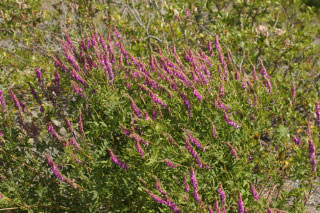
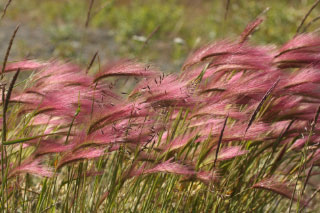
Chapter 11. Interior Alaska


(Bert) Itís a late start by the time we leave Anchorage, so we are driving Glenn Highway in the afternoon. To me the valley is much prettier when heading east, the mountains look taller and more sharply defined and, contrasting with early spring, the aspen are full with leaves and the sky is clear for our view of the Matanuska Glacier sprawled across the valley head. I pull off at the large parking area where the abandoned Trailhead Road heads north because I like the viewpoint here of the Chugach Mountains. I cannot find a single bird Ė post-breeding birds seem to completely disappear from much of Alaska Ė but I photograph a pretty patch of pink flowered Eskimo Potato and waving Squirreltail Grass. It is after 6 PM before we park R-Tent-III at Dry Creek State Recreation Site, just a few miles beyond Glennallen.
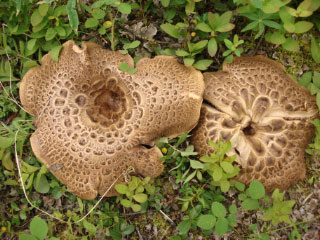 Day
81 - August 4 - Glennallen
Day
81 - August 4 - Glennallen (Bert) Autumn winds whisper through the Trembling Aspen. All my senses alert me to the seasonal change: dry crispness in the air, tasty autumn fruits of blueberries and crowberries ready to be picked, fall mushrooms arising from leaf litter, shriveling yellow-orange leaves on Labrador Tea. We start the morning with Shariís cheese omelets stuffed with Puffballs (Bovista pila) picked at our wooded campsite at Dry Creek SRS. Then we drive to the visitorís center for Wrangell-St. Elias National Park, our nationís largest national park encompassing 13.2 million acres and designated a park by President Jimmy Carter. Most of the park is essentially inaccessible except by air and today we are just on its western edge. In 1996 we ventured much farther in one the longer of two roads that penetrate the interior, the McCarthy Road going as far as the abandoned Kennecott copper mines. Today we see the exhibits at the visitorís center and hike a short trail that in part includes a portion of the original Valdez Trail used by some to reach the gold fields in the 1890s. We take another walk from our campsite late in the day and pick the Crowberries and the Early Blueberries that we will eat later, passing up on the more numerous but bitter Soapberries, which derive their name not from the way they taste but that when beaten they form a frothy mass like soapsuds. We also find more mushrooms and gather the puffballs, these of the Gem or Gem-studded Puffball (Lycoperdon perlatum). I find giant mushrooms I do not recognize, some nearly a foot in diameter. I pick two and later we identify them as Scaly Tooth, a stalked polypore (Hydnum imbricatum). Our books say they are edible, though not particularly delectable and we decide not to try them. But we have the Gem Puffballs for delicious hors d'oeuvres that Shari makes by dipping them in flour, egg and Panco and then baking them. For dinner we have baked clams, removed from our freezer since we caught them in early July. When our freezer empties of our supply, we certainly will wish we could dig more Razor Clams, as these are scrumptious.
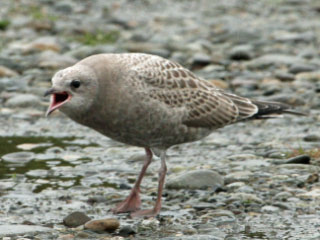 Day
82 - August 5 - Tangle Lakes
Day
82 - August 5 - Tangle Lakes (Bert) We drive north on the Richardson Highway from Glennallen to Paxton, a section of Alaska we have not visited since 1996. I donít recall the scenery or said another way, I recognize it all, since it is a continuous spruce forest without memorable landmarks except for a series of distant shallow lakes in an extended valley below the highway. Rain falls intermittently during our drive and drizzles more persistently when we set up camp at Tangle Lakes on Denali Highway. I was so looking forward to revisiting Tangle Lakes and I sit out the rain until Iím stir crazy and then put on my rain gear to explore. The juvenile Mew Gulls are now almost full size, gray feathers throughout, and still begging for food. Just as the rain comes to a near stop, out come the Wilsonís Warblers, all this springís crop, all shades of yellow absent of the black caps of adult males. I count 13 and then get confused as they crisscross through the willows, anxious to feed after the rain delayed hunting. Ahead of me, picking their way carefully downhill from a steep slope come a Moose cow and her two calves, now almost half-size. I loose them in the aspen and then later see the calves again on one of the grassy islands of Tangle River.
(Bert) Iím up at 6 AM and the skies are clear, but it looks cold. I wait until 6:45 and go outside with extra layers of clothes, raingear just in case, and my calf high Wellingtonís. The car thermometer registers the outside air at 39ļ as I head east along the Denali Highway. Barely started, I stop at an overview and a hunting Merlin patrols the slope, passing over my head just as a distant loon calls. Iím anxious to see what has changed since our visit in June and am surprised Iím still seeing a good number of birds. The Trumpeter Swan chicks are three-quarter sized now, the Mallard and Green-winged Teal are almost unrecognizable in eclipse plumage, the drake pintails have left behind a dozen females/immatures now all the same size, and the same is true for the five female/immature Harlequin Ducks fighting the swift current of Tangle River. A female Bufflehead still attends three toddling half-size chicks that trail her everywhere in a pond; she must have lost a few of her brood to predators.
A few miles farther down the highway, I stop suddenly and pull to the side when I see a family of Willow Ptarmigans cross in front of me. I watch these and then shortly thereafter a second family for an hour or so. The ptarmigans are nearly full-sized, so much so I donít always recognized the adult hen. The youngsters scurry around indecisively, stopping abruptly, screwing their four heads in four different directions and then quickly switching bearing. One starts across the highway, only to stop at the yellow line and look back to see if his cohorts are following. The hen clucks instructions, but the juveniles have grown independent and ignore her. Their plumage is camouflaged mottled brown except for white bellies and feathered white legs. When the young ones fly they reveal strikingly white wings. The hen stays behind at the side of the road, but after a minute or two decides to join her autonomous family, and in flight she too shows white wings, a reminder that soon they will be changing attire to all-white winter plumage.
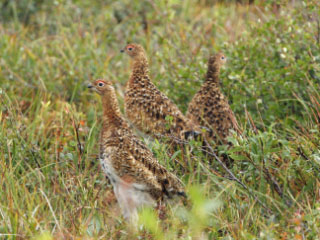
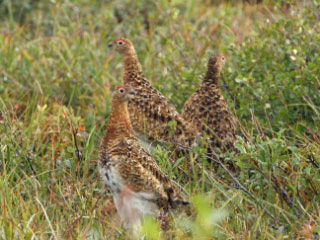
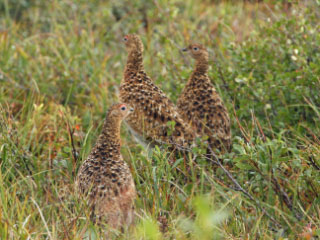
I enter the tundra on foot, looking in the area where I hope to find Smithís Longspur. I check out every sparrow, a challenge now to identify in their poorly marked juvenile plumage. Dozens of Savannah Sparrows, nearly as many American Tree Sparrows, a few White-crowned Sparrows and one Fox Sparrow, but no longspurs. In a small clump of low willow, a Gray-cheeked Thrush attempts to hide. Between bird happenings Iím easily distracted by the grand vistas across gray-green tundra, silvered pools of thaw lakes and purple-shaded mountains. At my feet fall flowers abound: Pink Plumes, Yellow-spotted Saxifrage, Few-flowered Groundsel, White Northern Oxytrope and the red stalks of Arctic Dock. The flower petals have fallen from the Arctic Lupine and bean-like seed pods remain, looking much like Texas bluebonnets.
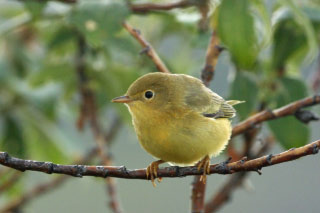 At
another stop the warblers are bountiful again and at first I assume the dozens
are all Wilsonís Warblers, but as I photograph the yellowish warblers I see wing
bars on one, a strong yellow supercilium on another and a few faint breast
stripes on yet another. Confusing fall immature warblers, I slowly recognize
Blackpoll, Orange-crowned and Yellow warblers among the lot.
At
another stop the warblers are bountiful again and at first I assume the dozens
are all Wilsonís Warblers, but as I photograph the yellowish warblers I see wing
bars on one, a strong yellow supercilium on another and a few faint breast
stripes on yet another. Confusing fall immature warblers, I slowly recognize
Blackpoll, Orange-crowned and Yellow warblers among the lot.
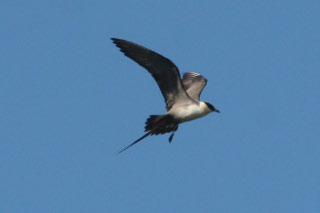
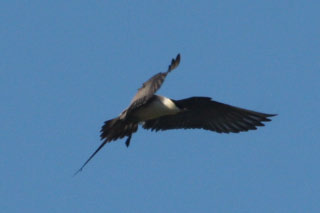
The last show of the morning is the Long-tailed Jaeger that puts on an aerial performance. Iíd seen both an adult and a dark short-tailed juvenile earlier in the morning. Now the adult hovers over my head. I snap photos of its stationary helicoptering flight, each frame catching the action at a different wingbeat. The adult has lost most of the yellowish tint to its throat feathers, but its long streamers still more than double the length of its tail. Using the tail as a rudder and rotating its wings fore and aft, but always above its head, the jaeger maintains its body in a stationary position and keeps its eyes aimed to the tundra in search of prey.
By 11:15 the thermometer warmed to 48ļ and by 11:45 it has climbed to 56ļ, enough so Shari accompanies me for a walk around the campsite. We find blueberries to pick and later cook our dinner over a hot campfire, ending a delightful fall day in the wilds of Alaska.
(Bert) We awake to serious rain and a dark low-ceiling sky that doesnít look like the raindrops will stop anytime soon. After a leisurely breakfast in the coziness of R-Tent-III we venture outside to attach the tow car and head out on the Denali Highway. As we climb slightly along the frost-heaved highway, the rain turns to snowflakes. Windshield wipers push aside the white flakes and I have to remind myself this is the first week of August. Our daughter and friends from Texas e-mail us about 100ļ-plus temperatures and nearly rainless months, but here it snows and the RVís furnace runs at night even with the thermostat set at 55ļ.
(Bert) Steve and Nancy are already at the Mendeltna campground and John and Carol pulled in just minutes before we arrived yesterday afternoon. Later, in come Bent and Marie and at 5 PM all resume our social hour around a campfire built with Bentís dry wood that I split thinly with my axe. After dinner, Steve and I resume our competitive card games against Shari and Nancy. Men easily win the first two rounds of 500, but the last set goes on through a nearly endless series of 15+ hands with the score frequently dipping negative and rebounding to near finish only to cycle once again. The men win two out of three, but the last marathon set lost to the women makes it feel like we lost all evening long.
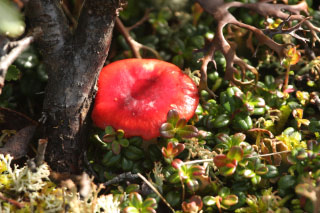 Day
86 - August 9 - Mendeltna
Day
86 - August 9 - Mendeltna (Bert) The thermometer reads 32 when I get up, but I stay inside most of the day until Shari and I take a walk and find a patch of blueberries to gather. I find a very attractive red-capped mushroom, put it in the bag with the blueberries and crowberries, and later get out my books. If I chose mushrooms for eating by how pretty they look, this one sure would get me in trouble. It is called Sickener in one book and Emetic Russula in another, and even the Latin name Russula emetica is ominous. Throughout the day, others in our group arrive and at 5 we gather for pizza and salad at the lodge, with lots of good conversation as we catch up on what each couple did during our break.